Friday, 27 February 2015
Just become a Landscape Ambassador for the Cotswolds and the North Wessex Downs
Join our guided walks and learn more about the countryside through which you walk.
Anne
Walk the Landscape
Tuesday, 24 February 2015
Signs of spring in the Cotswolds
Things are looking up. The cold weather and icy winds of winter are still hanging on, but despite this there are cheerful signs of spring wherever you look.
Snowdrops blooming under trees, in hedgerows and in churchyards.
Snowdrops have been cultivated since the middle ages and are associated with abbeys
and churchyards as they are a symbol of the Catholic festival of Candlemas. They are normally flowering on 2nd February when Candlemas is celebrated and they are looking particularly fine this year.
A robin collecting material his or her their nest.
(male and female look the same)
According to
folklore it is said that when Jesus was crucified on the cross, a robin flew
down and removed a thorn from the crown on his head and sang to him, thus relieving his suffering. The blood of
Jesus stained his throat and chest, and ever since his breast has remained red.
Lambs appearing in the fields.
These babies are sticking close to mum where there is always a constant supply of food.
Mum is a type of sheep known as a 'mule' and is a crossbreed between a hardy upland ewe and a lowland ram.
Best
Anne
Friday, 20 February 2015
A hidden backwater of the River Thames at Radcot Bridge
Labels:
hiking tour,
Radcot bridge,
Thames Path,
Walking holiday
Location:
Radcot Bridge, Oxfordshire, UK
Monday, 16 February 2015
Cotswold Country Houses: History and Grandeur along the Trail
Scattered through the Cotswolds are fine country mansions, manor houses and there is even a palace. Our network of public footpaths, which date from ancient times, often pass very close to them and here are some of the historic houses next to our routes.
Blenheim Palace is the sumptuous home of the Dukes of Malborough. The estate together with funds to build the palace were given to John Churchill, 1st Duke of Malborough, by Queen Anne and parliament, who were grateful for his victory over Louis XIV of France on 13 August 1704 at the Battle of Blenheim. John Churchill went on to win other battles in the War of Spanish Succession (1701-1714) and the palace is a memorial to him and his military victories.
 |
| Chastleton House |
Chastleton House is a Jacobean country house built between 1607 and 1612. It was built by Walter Jones, a wealthy lawyer and wool merchant, with no expense spared. But the family were Royalists during the English Civil War (1642-1651) and in the 18th century they supported the Jacobite cause, which aimed to restore a Stuart king to the throne removing the Hanoverian dynasty. As a result the family was heavily fined for its political views. Subsequently, their fortunes did not improve and when the National Trust took the house over in 1991, the interior was much the same as it had been in the 1612. It remains so today, as the National Trust have done only essential repairs, thus retaining the unique 17th century atmosphere.
Our guided and self-guided day walk, ‘Adlestrop: Where for a moment a blackbird sang’ passes Chastleton House, and the house is open to the public on Wednesday to Sunday afternoon from early March to the end of October.
 |
| Blenheim Palace |
Blenheim Palace is the sumptuous home of the Dukes of Malborough. The estate together with funds to build the palace were given to John Churchill, 1st Duke of Malborough, by Queen Anne and parliament, who were grateful for his victory over Louis XIV of France on 13 August 1704 at the Battle of Blenheim. John Churchill went on to win other battles in the War of Spanish Succession (1701-1714) and the palace is a memorial to him and his military victories.
Set in a country estate, the view of the house and lake was described by Randolph Churchill as ‘The finest view in England’ to his future wife on her first visit. Their son, Sir Winston Churchill(1864-1965) was born there and he is buried in the churchyard at Bladon, next to the estate.
We can arrange a short break of walks in and around Woodstock and Blenheim Palace. Walkers along Shakespeare’s Way and the Oxfordshire Way pass through the estate getting magnificent views of the lake and palace beyond. The palace is open daily from mid-February to mid-December.
 |
| Sezincote House |
Sezincote House, which lies on the spring line at the eastern side of the North Cotswolds, was designed in the “Indian Style”, by the architect, Samuel Pepys Cockerell in 1805. The gardens were designed by Humphrey Repton, the eminent horticulturalist who is considered the last of the great British landscape gardeners. When the Prince Regent visited the house in 1807 he admired the unique combination of Hindu and Muslim architecture, and it is said that it influenced the design of his exotic oriental retreat, the Brighton Pavilion.
Our ‘Classic Cotswold’ tour passes Sezincote on the routes from Moreton-in-Marsh and Chipping Campden to Stow-on-the-Wold.
 |
| Abbotswood House |
Abbotswood
is a lovely country house near Stow-on-the-Wold. The estate dates back to 1253, but
the current house was built in 1867. Shortly afterwards it was remodelled and
enlarged in 1902 by Edwin Lutyens, the eminent British architect who adapted traditional
designs for modern day living. Lutyens
also designed the stunning gardens and these are open to the public in April
when the rhododendrons in bloom and in October when the acers are in full
autumn colour and at other times of the year – this photo was taken in
mid-summer. For people with deep
pockets, the house together with the estate and 13 cottages was recently on the
market for £30 million.
On our shortbreak based in Stow-on-the-Wold one of the walks passes through the estate.
Please contact Anne, to find out more or to book a walking holiday.
Happy hiking
Anne
Walk the Landscape
Sunday, 8 February 2015
Visit Ancient Cotswold Churches Steeped In History
On your walking tour through Cotswold towns and villages take the opportunity to visit ancient churches
These historic buildings are steeped
in history and are often the oldest building in the town or village, some
dating back to before the Norman Conquest in 1066.
St Eadburga's church, Broadwayy. This 12th century church is
dedicated to St Eadburgha, the grand-daughter of Alfred the Great. The legend goes that as a child, her father King
Edward, tested her faith and when offered the choice of a gift of jewels or a
bible, she chose the bible and subsequently dedicated her life to God's service. In the 19th century
by a new building closer to the centre of the town, but St Eadburgha’s
continued to be used in the summer, for special candlelit services over
Christmas and for burial services.
Flower arrangement at St Nicholas, Oddington with the 14th century Doom painting on the wall behind.
Painted when most of the population could not read or write, when the
service was in Latin, wall paintings told worshippers bible stories. The Doom or Last Judgement painting shows God
in Heaven with souls on their way to heaven on his right hand side and others
on their way to hell on the left hand side.
The chancel at St Michaels, Buckland, a beautiful small village church
under the Cotswold edge.
St John the Baptist, Cirencester is one of the famous
Cotswold ‘wool churches’. In the middle
ages, the fleeces of many thousands of sheep raised in the Cotswold were
exported into Europe and the wool merchants in area became very rich
indeed. In the 15th century
some of this wealth was used to rebuild parish churches in grand style and the
church as Cirencester is one such.
Happy Hiking
Anne
Subscribe to:
Comments (Atom)



.jpg)





